Pulitzer Center Update February 24, 2017
Making Sense of the World—and of Donald Trump
Country:

What follows is an edited version of the talk delivered by Pulitzer Center Executive Director Jon Sawyer at the Arbor Acres retirement community, Winston-Salem, NC, on Monday, Feb. 20th, 2017.
Some of you may recall that I was here about a year and a half ago, in the summer of 2015, and that I gave a talk then about the state of the world.
My message that summer was the case for hope—that the world is in better shape than many of us think. I acknowledged that might be a surprising view coming from an organization like the Pulitzer Center, which specializes in crisis reporting of systemic global issues that range from conflict to health, education, and economics. But I said that if you look at any number of basic indicia—from levels of violence, the number of people killed in conflict, to life expectancy, child mortality before the age of 5, or the average income of people around the world, you’d find that there has been phenomenal progress, in our lifetimes and even in the last 25 to 30 years.
But I have a feeling that maybe that’s not the part of my talk that is remembered most. I wonder if anybody here remembers what else I might have said in that talk that I’ve been hearing a lot about since. That’s correct—in the question period one of you asked me what I thought about the prospects of Donald Trump and I said there wasn’t a chance that a candidate like that would be nominated or elected.
So the small thing that I missed, as I surveyed the state of the world in the summer of 2015, was Donald J. Trump. He had announced his campaign for president about a month before I came down here.
And I imagine some of you are thinking today: What better example of how out of touch Washington journalism can be?
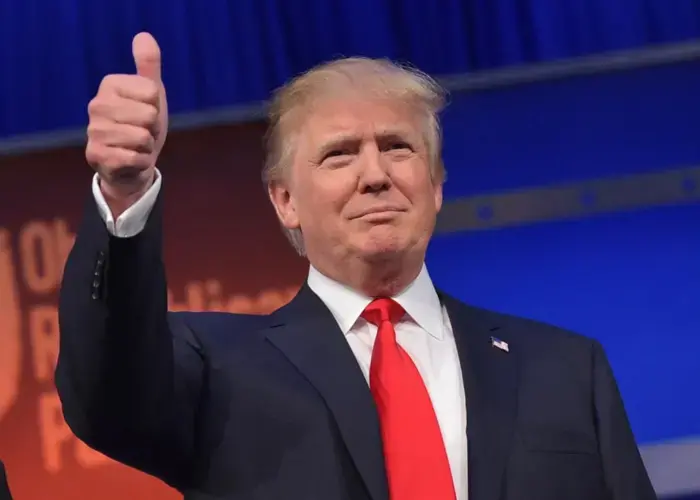
At that point, back in 2015, I’d only been in Washington for 35 years. So maybe I can say now with 37 years’ experience in Washington I wouldn’t have made that rookie mistake—and that I would be a better prognosticator of what was going on with Donald Trump. I could say, in my defense, that when I gave that speech, Trump had only announced his campaign a month before. There were 16 candidates running against him, some of the most formidable senators and governors in the party and with lots of money lined up behind them. It was certainly reasonable to think that a reality-TV star and New York real estate developer was not going to be able to stand up against the likes of all those running against him.
I might also say, in my defense, that in the months since Trump announced his candidacy a year and a half ago, I have said many times that the Democrats were headed in a very perilous direction, for their own prospects—and that in Hillary Clinton they had a flawed candidate who made the country ripe for just the kind of anti-establishment, anti-Washington campaign that we saw from Donald Trump (and also from Bernie Sanders).
But looking back, what I really want to say is that I feel I violated one of the cardinal rules of journalism. One of those rules is you don’t make predictions outside your own area of expertise. You remember that you’re a journalist. You’re not a political expert. And my job as a journalist is to find out what you all think. And, I think, had I spent more time and questioned enough, if I had given you a truly honest answer, “I can’t imagine what’s going to happen—I think it’s very unlikely, but who knows? What do you think?” I wish I’d asked that question more than a year and a half ago. Considering how Winston-Salem voted, how North Carolina voted, and how a big chunk of the country voted, I probably would have learned a lot had I thought through and really asked that question, to know what your thinking was—and why it was that we’d gotten to the point where people thought there was a need for a truly radical shake-up.
We’ve been through, in the last 4 weeks, one of the more tumultuous transitions of our presidential administrations, certainly for the 40 years I’ve been in journalism and maybe for all of you, too. I’ve seen various shaky transitions, from Bill Clinton losing an attorney general to Ronald Reagan losing a Supreme Court nominee or two, but the sheer volume and rapidity of what we’ve gone through in the last month is dizzying for all of us.
Kem and I came over from the airport in an Uber. There was a very nice man who picked us up, who works for Time Cable. And as we were arriving, he brought up that he’d heard the president refer to a poll in his press conference last week, saying his approval numbers were through the ceiling as was the approval for the administration. “What do you think about that?” he asked. I tried to explain that there was one poll that had his approval numbers going up (Rasmussen, to 55 percent positive) but that in the polls generally considered more reliable—the ones based on live telephone interviews—the president was still down around 42 percent, which is one of the lowest numbers for a news president since presidential polling began.
We went back and forth on that, trying to find some common ground, and he said that in his opinion if everyone would just get off the president’s back, let him breathe a bit, then everything would be all right. I said I felt sort of the same way—that if Donald Trump would just let us breathe a bit, give us a break from the constant barrage of tweets and insults and flip flops on policy, it would be better for us all.
I do think that if he did slow down a bit, take that breath, and think through his priorities, he might accomplish some good things for the country—if it weren’t for these tweets coming every morning, reversing something that someone else in the administration had said the previous day or else saying something that [Vice President] Mike Pence or [Secretary of State] Rex Tillerson or [Defense Secretary] Jim Mattis then goes out to correct. It’s all just exhausting and it’s hard to determine after a while what is true and significant and what isn’t.
You get the sense in this White House that it’s the president and Steve Bannon and a few other people who aren’t exactly shooting from the hip, but they’re making some very quick decisions among a small group of people that often catches the government by surprise. 0f course, a prime example of that was the announcement that came out on the three-month ban on immigrants from these seven countries that were suspected of terrorist activity and a temporary ban on refugees from the entire world. And, as you know, that then precipitated dozens of lawsuits around the country and some judgments against the administration including theNinth Circuit Court of Appeals... And if you look at the way that was framed by President Trump, this was a clear black and white issue: we are going to protect ourselves from a very dangerous world, and this is the way that we’re going to do it.
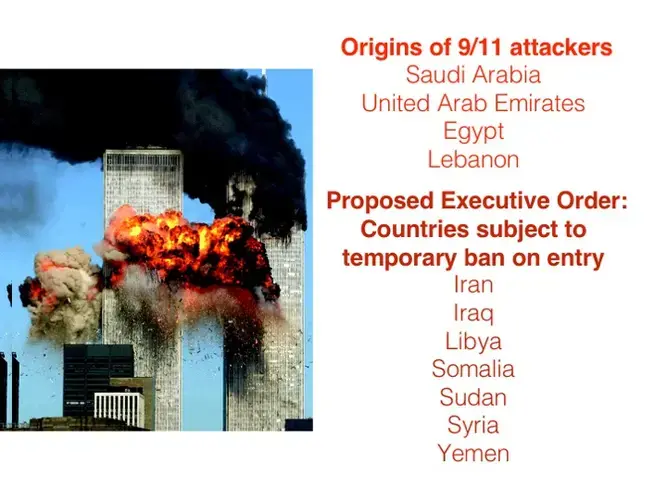
In this slide you see the countries associated with hijackers behind the 9/11 attacks: Saudi Arabia, United Arab Emirates, Egypt, and Lebanon. None of those countries are affected by the president’s proposed new ban on entry to the United States. And here you also see the seven countries that were affected. No citizen from any of those seven countries has been associated with any terrorist attack in the U.S. in the 16 years since 9/11.
And on top of that disconnect you had the president using harsh rhetoric, during the presidential campaign and since, that suggested the real target of the proposed entry ban wasn’t Islamic extremists or terrorists but Muslims per se. That became part of the litigation too—that the proposed order was an unconstitutional exercise targeting a specific religious group.
We will no doubt see in the next few days a new version of the executive order and ultimately he will probably get most of the restrictions he seeks. The president has huge latitude when it comes to control of our borders. President Obama exercised that latitude during his administration. President Bush certainly did after 9/11 and President Roosevelt did too, if you think back to the internment of Japanese Americans during World War II. For good or ill presidents, constitutionally, have a lot of power.
But what President Trump attempted these past few weeks was done in a way that stoked up a lot of controversy, got him on very thin ice legally, and then quickly turned into this ad hominem dispute between the president and the courts. When the district judge in Washington state ruled against him the president characterized him as a “so-called” judge. And then when the Ninth Circuit rules against him he talks about what a terrible track record that court has, in terms of its decisions being overturn at the Supreme Court. Of course we’re all familiar with this from the campaign, the demonization of his opponents and the personal attacks. But I question where the value is in this approach. Why gratuitously do things that produce these kinds of adverse results?
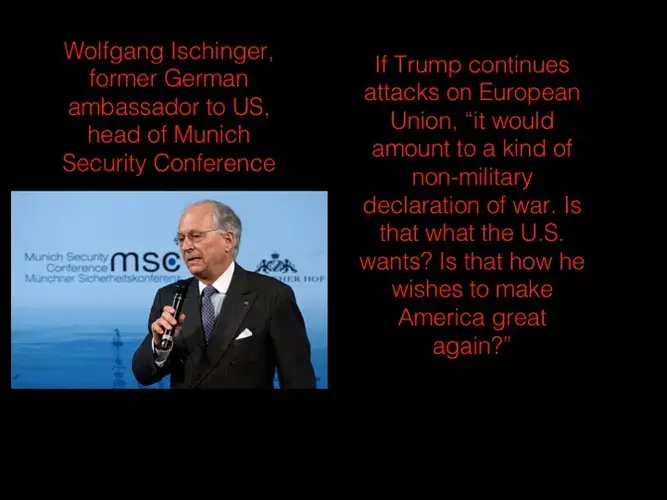
What about America’s relationships with the rest of the world?
I’ll start with the Munich Security Conference, the most important security gathering of the year and the most visible manifestation of the alliance between the U.S. and its European partners. You may have seen this statement over the weekend from Wolfgang Ischinger, the head of that conference and the former German ambassador to the U.S., and also a widely respected statesman. He characterized what the president has said denigrating NATO and the European Union, and encouraging more countries to follow the lead of the British in voting to leave the EU. Ischinger said that if the U.S. proceeds down that path it would amount to a kind of non-military declaration of war. And he asked: “Is that what Trump wants? Is that how he’s going to make America great again?” The merits of the argument aside, there is a real question about framing the issues in a way that exacerbates tensons with long-time allies such as Germany. What does that accomplish?
Today, Mike Pence gave a talk at the Munich conference saying that actually we’re totally behind NATO, we’re totally committed to the European Union. He said the kinds of things that have been very conventional wisdom as to American policy for the last six decades or so. It was surprising only because it was contrary to what the president had just said, whether it’s in tweets or at the campaign-style rallies he’s done since being elected. It goes back to the question I raised before. What is the purpose of trying to confuse the message that’s going out?”
We’ve seen a lot of this in the first month of the administration, and not just in what I think of as the gratuitous shooting of themselves in the foot. It’s a whole series of things that have happened that have stirred people up. And I’m not sure what the positive flip side of that is, from the Trump administration’s point of view. It’s a lot of noise and emotion, in the process overwhelming a number of things the president has done that have been surprisingly successful.

So you saw him playing golf with Shinzō Abe, the prime minister of Japan, and they clearly had a very constructive meeting. In general, they were on the same page, and President Trump was certainly acknowledging in his characterizations of that meeting that we have shared purpose and both of us have a concern about what’s happening in China and North Korea. Most of the foreign-policy expert types whom I follow thought that this was an encouraging meeting.
In some respects the same was true for his meeting with Prime Minister Bibi Netanyahu of Israel. Think about it: During the campaign President Trump, like Ronald Reagan before him and many Republican candidates since, made a big thing about how he was going to move the U.S. embassy from Tel Aviv to Jerusalem—which if you’re a Palestinian trying to hold to the 1967 borders, is about as provocative a thing as you can do. Trump, again like Reagan and others before him, signaled in the days leading up to Netanyahu’s visit, that he was backing off that position, that shifting the embassy is no longer viewed as likely soon. He also talked about the adverse consequences of what Netanyahu has pushed, including increasing the number of settlements in the occupied West Bank.
He did say something at the press conference with Netanyahu that stoked new controversy, when he said that he could live with a two-state or one-state solution to the Israeli-Palestinian conflict—whatever the two sides themselves might accept. Standard U.S. policy for decades has been to favor a two-state solution and for most of that time you have had the Israelis on record as favoring a two-state solution too. But even on this fraught subject I think it was refreshing, as one commentator put it, to have President Trump be the guy who’ll say the emperor has no clothes—that when you’ve got hundreds of thousands of Israelis busily populating the West Bank, it’s hard to conclude otherwise than that the two-state-solution idea for the moment is dead. And we need to rethink what we’re going to do. And it may be that, in the end, the Israelis must accept a bigger one-state in which there is true political power for the Palestinians and other Arabs—and who will eventually dominate that country demographically. My point is that there are big questions that have to be addressed. It may be that shaking things up, President Trump may well open the door to a conversation we need to have. I count myself among the skeptics on this—but I acknowledge that it’s a possibility.
And on the domestic side you had the nomination of Neil Gorsuch for the Supreme Court. Gorsuch’s judicial philosophy wouldn’t be my philosophy, or the philosophy of most Democrats, but as I look back at all the nominees by Republican presidents with a commitment to conservative judicial philosophy I can’t think of anybody who would surpass Neil Gorsuch in terms of professional acumen, character, and integrity. He’s also a superlative writer who knows how to speak as plainly as Antonin Scalia (but mostly without the famous Scalia barbs). I think the Democrats, after their initial foray of trying to demonize him, have pulled back because they realize just how strong a nominee he is.
So that was a nomination that was widely seen as strong and good that came out of this administration. The White House today announced another, retired General R. H. McMaster as the replacement National Security Adviser for Mike Flynn, another general, who preceded McMaster in that job and who was forced out of the position. Mike Flynn is a mercurial personality, very combative with some extreme views. McMaster is much more in the category of General Mattis at the Defense Department, or Gen. John Kelly at Homeland Security. These are people who enjoy big bipartisan support.
Rex Tillerson is a serious person too. Again I wouldn’t have done some of the things that were done at Exxon Mobil over the past 30 or 40 years, but there’s no question that he is a deeply qualified, competent person, at home in just about any country in the world. So you sort of look at that and think: “This could work, this trio of appointments.” That would be a pretty good way to start an administration, to get all this done in just the first four weeks. It’s unfortunate that we’ve had a lot of other things come up too—things that have undercut the administration’s own goals and that aren’t the fault of “fake news,” the Democrats, or anyone else.
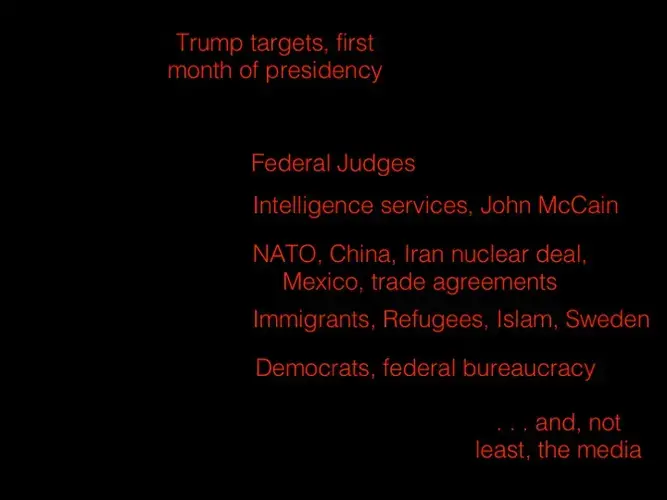
This is a list of some of the targets the president has taken on, many of them in early-morning tweets but sometimes in the afternoon, as well. Sometimes he’ll make the attack at a press conference or rally. It’s a pretty eclectic list: from federal judges to intelligence services to Sen. John McCain. Or China: In the presidential transition he suggested that maybe we would abandon the one-China policy embraced by every president since Richard Nixon—and maybe throw in a trade war, too. The Iran nuclear deal. Mexico. All multilateral trade agreements, immigrants, refugees, Islam. As I say, it’s a long list.
And then this weekend there was Sweden. The President had a rally Saturday afternoon saying that Europe had terribly permissive policies on refugees, letting in all of these criminals and terrorists, and he said “Just look at what happened in Sweden last night.” So then people spent the next 24 hours trying to figure out what he was talking about. Had something happened in Sweden, or not? The White House eventually explained that the president had heard something on Fox News Friday night, something about how levels of crime had gone up over time in Sweden and other parts of the world, and that there might be a correlation between that and the influx of refugees coming in. That’s different than saying that something happened Friday night in Sweden. This is more in the category of talking about a Bowling Green massacre as if it ever happened, as if it were true.

Of course, he has also attacked Democrats, in general, and the federal bureaucracy. And, not least, the media, which has been a major target indeed. That was something else that dominated news coverage this weekend. He has been riffing constantly about the “fake media” and “fake news,” of course, but the tweet this weekend was especially strong, saying “The FAKE NEWS media (failing@nytimes, @CNN, @NBCNews and many more) is not my enemy, it is the enemy of the American people. SICK!”
Trump is hardly the first president or politician who has attacked the media, but he brings a special gusto to his assaults. It appears that every piece of journalism critical of him is bogus, not true, or fake. This kind of frontal attack is different, something we haven’t really experienced in the past.
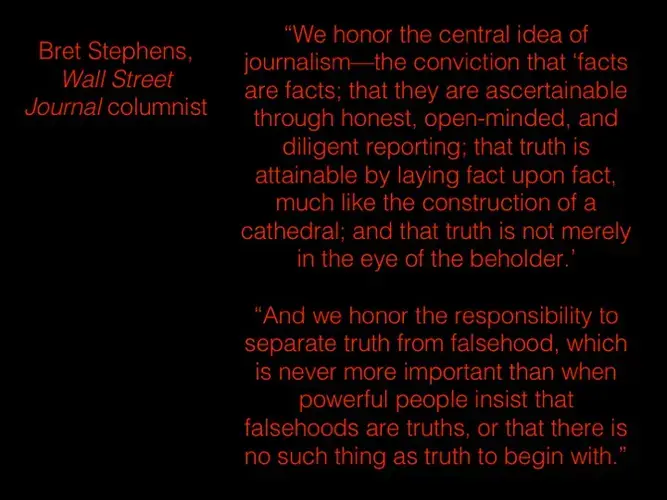
This was a talk over the weekend out at University of Southern California. Brett Stevens of The Wall Street Journal is very conservative but was also part of the “Never Trump” movement within the Republican Party during the primaries. He was giving the Daniel Pearl Lecture, a lecture they have every year in honor of The Wall Street Journal reporter who was beheaded in the course of his reporting in Pakistan back in 2002. Danny Pearl was a wonderful, wonderful reporter. In the talk Brett Stevens said “We honor the central idea of journalism—the conviction that ‘facts are facts; that they are ascertainable through honest, open-minded, and diligent reporting; that truth is attainable by laying fact upon fact, much like the construction of a cathedral; and that truth is not merely in the eye of the beholder.
“And we honor the responsibility to separate truth from falsehood, which is never more important than when powerful people insist that falsehoods are truths, or that there is no such thing as truth to begin with.”
That’s the dangerous thread of what’s happening right now.
I think this moment will pass. I don’t see this as moment as quite so fraught as it appears to some of my colleagues. Marvin Kalb, my dear friend and senior adviser at the Pulitzer Center, has been at this business for 65 years. He gave a talk last week where he suggested that Trump’s assault on the media, and on basic constitutional norms, is unlike anything he has ever experienced—and that comes from a man who was once on Richard Nixon’s enemies list. I don’t go that far. I think the checks and balances are working pretty well. I think that a lot of this is bluster, unhelpful but more talk than action. If the president or the administration take further steps, if they weaponize these attacks on the media by taking legal action against specific journalists or using the government’s power (or tweets) to undermine the position of individual outlets, that would be a very, very dangerous thing to the United States.
But in the meantime what is problematic about this approach is the confusion engendered by the tsunami of assertions and the labeling of this is fake, this is not fake, and so on. Here’s one example, from the president’s press conference last Thursday. He volunteered that the 306 Electoral College votes he received in November was “the biggest Electoral College win since Ronald Reagan.” Wrong. George H.W. Bush, Bill Clinton, and Barack Obama all scored bigger victories. But when a journalist pointed out the error, later in the news conference, Trump brushed the criticism aside. “Well, I don’t know,” he said. “I was given that information. I was given—I actually, I’ve seen that information around. But it was a very substantial victory, do you agree with that?”
This is along the same lines as the president’s repeated claims about the size of the audience at his inauguration or the 3 million people who supposedly voted illegally for Hillary Clinton so as to account for her popular-vote majority. You have to wonder why such basic misstatements keep getting made. The result is that we’ll end up with none of us being able to distinguish between what’s actually true and what isn’t, what’s an important fact and what’s an unimportant fact. If that’s the climate you’re in you are subject to all kinds of manipulation—and that’s not good for any of us.

One issue where basic facts, truth and falsehood, are going to matter is Russia—the nature of President Trump’s relationship with that country and the extent of Russian interference in our electoral process.
I think we will get to the bottom of this. The issue has already cost the national security advisor his job, because of his belated acknowledgment that during the transition he had talked with the Russian ambassador about the possibility of lifting U.S. sanctions and that he had misled Vice President Mike Pence about that conversation. There’s a live question as to whether he may have misled the FBI as well. Then there is the reporting that has come out over the last week, including this morning, about the contacts pursued by President Trump’s private attorney, including people in Ukraine and the idea of trying to develop a proposal that would allow us to lift sanctions against Russia and have an opportunity for the Crimean annexation to be accepted internationally. That sort of alleged freelance diplomacy is going on against the backdrop of the campaign and the presidency so far.
The president continues to be oddly enamored of Vladimir Putin, going so far that in a recent interview with Fox’s Bill O’Reilly he brushed aside concerns that Putin was a killer. “We’ve got a lot of killers,” he responded. “What, you think our country’s so innocent?”
Of course there’s some painful truth to what the president said. We have a lot on our hands as a country. A lot of times we have not lived up to our ideals as a democracy and as a constitutional republic. But does that mean we equate ourselves with some of the worst practices in the world?
And again, incidents like this raise the question of why—why is this happening? What are the motivations for these extreme, unnecessary nods toward the ruler of Russia? These are questions that I don’t think are going away anytime soon.
It’s interesting that Sen. Richard Burr, who grew up right here in Winston-Salem, whose dad was our long-time minister at the First Presbyterian Church, now finds himself in the tough spot of serving as chair of the Senate Intelligence Committee. Richard was a Trump supporter but in the past few weeks he has acknowledged the issues raised about the Russian connection are serious. You have people like Sen. Mark Warner of Virginia, the ranking Democrat on the Intelligence Committee, saying that he believes Richard and the Republicans are committed to a serious investigation about what happened with Russia.
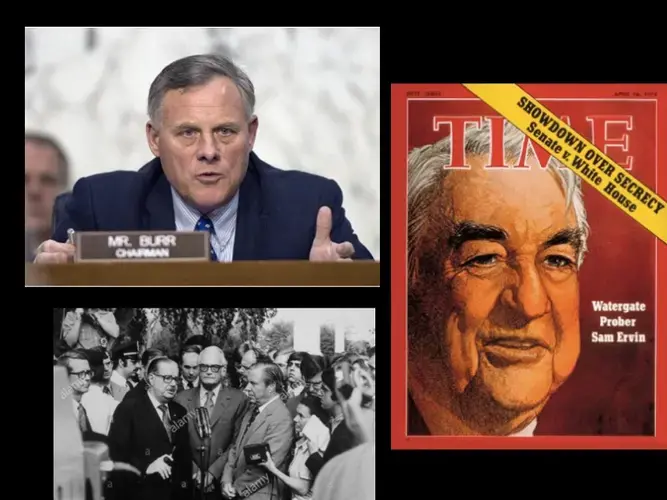
What is going on with this Russian connection? How much of a role did Russia play in terms of hacking in the last election? My own hope, and belief, is that President Trump’s direct connection to this affair is likely not as significant as Democrats have alleged. He has made categorical statements that he and his associates have done nothing wrong. But I keep going back to Mike Flynn, to the fact that he kept these things secret from Mike Pence and from others, and also the fact that unlike every president since Nixon President Trump has refused to give us access to his tax returns. So there are questions that have come up.
And if it turns out that there is substance behind some of this swirl of accusation and speculation, I think you’ll start to see the many checks and balances on the power of any president begin to function in earnest. You have the media, you have the opposition party. You have the judiciary. You have the bureaucracy, the so-called ‘deep state,’ people who have been in the government for years and have a commitment to what they see as settled order, and the way things should be done.
We may be fine. The current tempest over Russia may come to a lot of smoke and not much more. Things may settle down—and the focus may shift to the border wall or jobs or infrastructure or all the other things that Trump has vowed to make the signature of his presidency. But we’re not sure yet. And if it turns out that on Russia we’re dealing with something truly serious, truly fundamental, then people like Richard Burr may be called on to play a very important role.
I was thinking about Sam Ervin, another North Carolinian. He was a very conservative Democrat, much more attuned to Richard Nixon than to Democrats like George McGovern. Yet he led the Watergate committee and when things went really bad with Watergate, it was Sam Ervin who became the unlikely constitutional hero who stood up. And equally important in terms of driving Nixon to believe that there was no future for him, that he was going to have to resign, was this trio of senior Republicans. That’s Barry Goldwater in the middle, and Hugh Scott, the Republican minority leader in the Senate, and John Rhodes from Ohio, the minority leader at the time in the House of Representatives. In August of 1974, those three went down to the White House at Goldwater’s instigation. They met with Nixon, a fellow Republican they had known for decades, and they told him: “You’re done. It’s not sustainable.” Two days later, Nixon boarded the helicopter for exile in San Clemente.
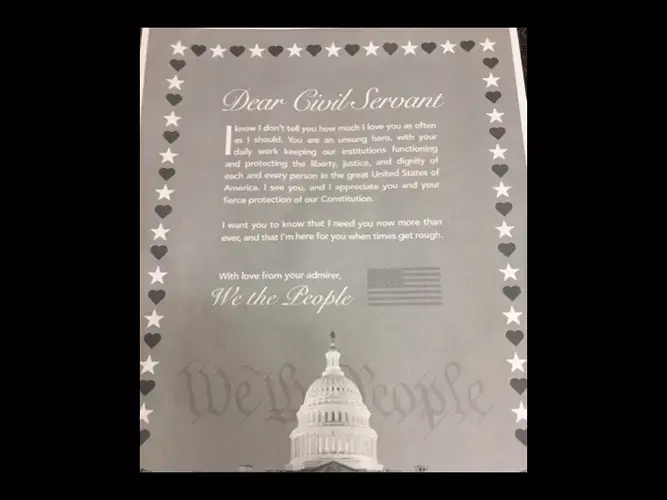
Along those same lines, here’s something that showed up in the hallways of the State Department over the last week, a sheet that people are putting up anonymously. It says:
“Dear Civil Servant,
“I know I don’t tell you how much I love you as often as I should. You are an unsung hero with your daily work keeping our institutions functioning and protecting the liberty, justice, and dignity of each and every person in the great United States of America. I see you, and I appreciate you and your fierce protection of our Constitution.
“I want you to know that I need you now more than ever, and that I’m here for you when times get rough.
With love from your admirer,
We the People
So, as I say, after these tumultuous first weeks it may all settle down. But it’s important to note where we are, what the stakes might be, and that there are forces and counter-forces engaged and activated now and on alert. That’s going to continue.
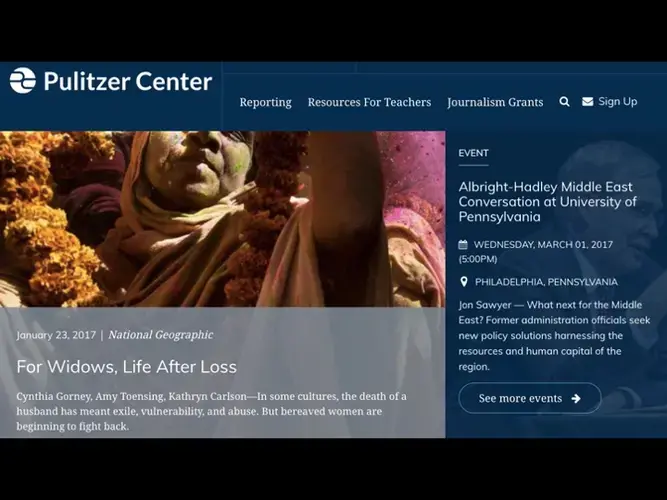
I want to turn now to some of what we do at the Pulitzer Center—because what we’ve been discussing this past hour is not my usual business. Our focus is on international issues, using great journalism and educational outreach to engage the broadest possible public in the big issues that affect us all. We do about 150 journalism projects a year. We’re the biggest source of funding for enterprise reporting on global issues, with about $1.6 million in direct support for journalism in just the past year. We work with The New Yorker, The New York Times, PBS NewsHour, The Guardian, Financial Times. Lots of different outlets. And we take that journalism out to our network of schools and universities across the country, arranging for the journalists to go out and speak, and we get support from those educational institutions to help bring the journalists into the classroom and spark more discussion and conversation with those journalists firsthand. We’re thrilled that Wake Forest is one of our Campus Consortium partners, as are Guilford, Davidson, High Point, Elon, and many more. We’re also working now with schools here in Winston-Salem, as well as in Chicago, New York, Philadelphia, St. Louis, Washington and beyond, seeking a broader conversation about all of these issues that we think are important for us to debate.
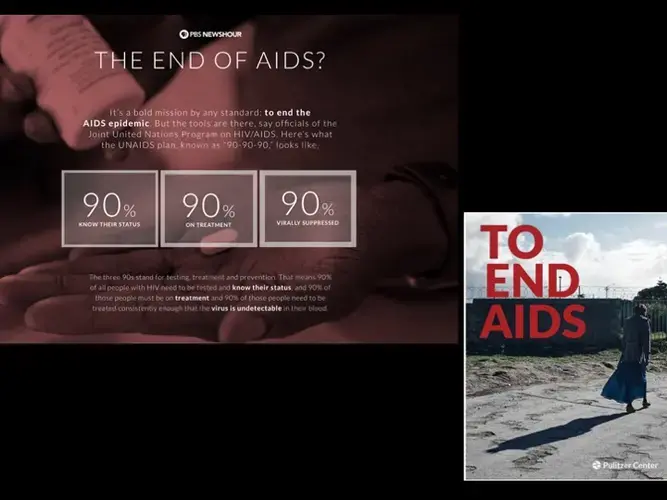
Last year we did a six-part series for PBS NewsHour on trying to end AIDS. We did half a dozen other projects on that topic around the world. We created an e-book, that Kem edited, which brought together all of the reporting that we had done and then we created education lesson plans. We have something called the Lesson Builder on the Pulitzer Center site. Any teacher in the world can freely use any of these thousands of journalism resources—stories, videos, photographs, etc.—to bring these issues to life in the classroom.
We’ve done a lot of work on refugees. This is something very dear to us because we are so conscious of this country being a country of immigrants and how much we have been enriched by them. We are what we are because of our openness to people coming in. America is a place of refuge for people who need it, so we’ve done reporting on refugees from Syria in another e-book that collected that reporting. We’ve also just launched a year-long project on this topic with Time Magazine.
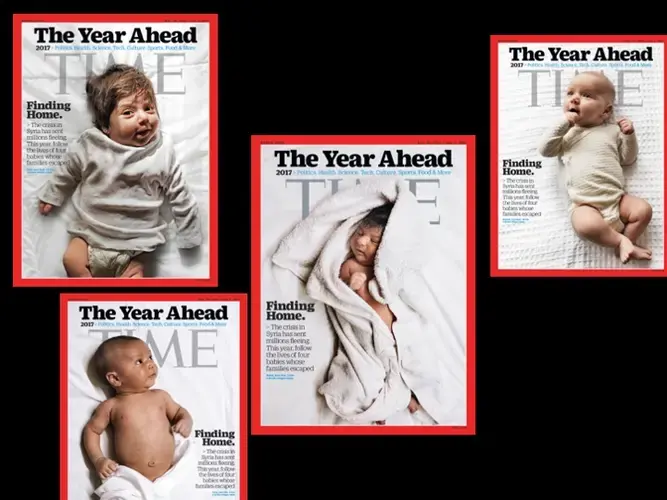
Lynsey Addario is the photographer on this project: these are four Syrian refugee babies, who were born in refugee camps in Greece over the course of last fall. Over the rest of this year Time, with our support, will be revisiting these families and telling the story of how they’ve adjusted to life in Europe, what their challenges are, how they are trying to stay in touch with their home countries.
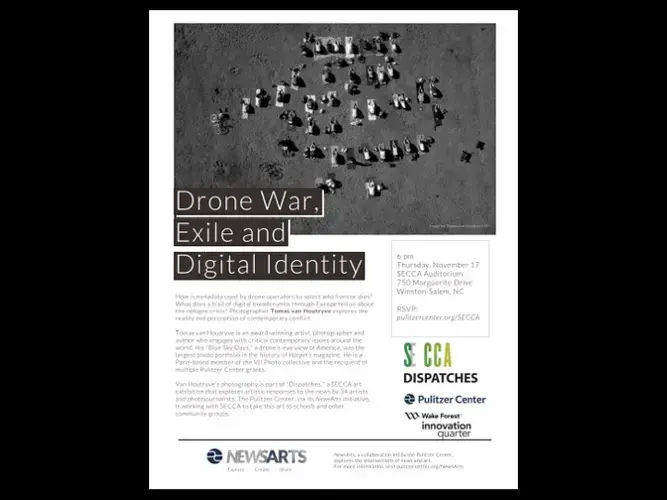
This is our project on drone wars. The photographer is Tomas Van Houtryve, who is based in Paris but who came to Winston last fall as part of our work with SECCA on the exhibit “Dispatches" which looks at the intersection of news and art. Tomas and three other photographers from around the world, all supported by the Pulitzer Center, were featured in the exhibit. One of the topics Tomas addressed is how we view the use of drones in warfare. It has become such a large part of our foreign policy, an initiative begun under George W. Bush and embraced by Barack Obama and now inherited by Donald Trump. What Tomas did was use a drone camera to take videos of everyday scenes in America—a yoga class, students on a high-school athletic field. He then overlay those shots with transcripts of our military drone operators targeting enemies for strikes in Yemen, Somalia, Iraq, Afghanistan, and beyond. It’s very chilling to see what this looks like, from the operator’s perspective, and to know that this is now a principal tool in the way we fight.
We also funded a project with Tomas and The New Yorker, tracking refugees going right across Europe. He combined photographs of the places that they were in as they went from Turkey to Greece to France, and then overlayed the social media from these individuals. That’s the one thing almost all of these refugees have—their smartphones. Everything else they left behind in Syria or wherever. But with their phones they were putting up posts on Twitter and Facebook, so you could track both how they were presenting themselves and how they made their way across Europe.
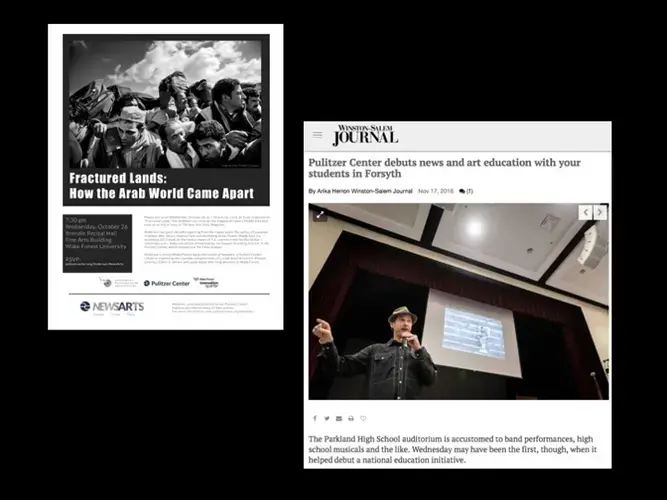
We took those projects and presented them as part of our new initiative NewsArts, which is headquartered here in Winston-Salem and that we are thrilled about. We want to make Winston-Salem the hub for that and take the work and spin it around the country using our online curricular resources, to get everybody thinking about using art as a way to tell stories and also how art can help us respond to the news. We had Tomas go and present the work at Reynolds High School, which has a fabulous arts magnet program here in Winston. It’s also where I went to high school (and where my mother had an illustrious six-month career as a biology teacher before she left to marry my dad). At Reynolds this year the students who worked with Tomas created a dance movement responding to the drone warfare and refugee projects. The results were spectacular, part of a performance devoted in whole to the issues raised in SECCA’s “Dispatches” show.
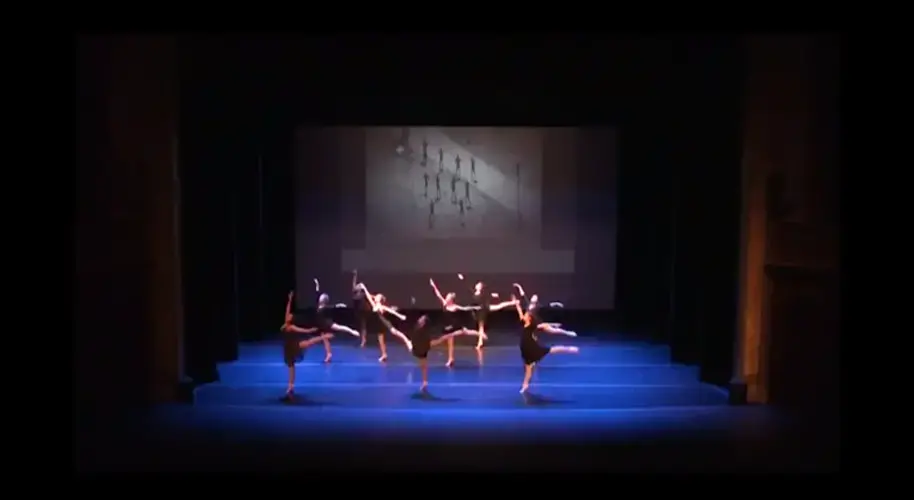
Here’s a 10- or 15-second clip from the dance. The whole thing is on YouTube, and, if you haven’t heard about it, they did a really great job. For us it’s inspiring to see how engaged these students are, how smart they are, and their eagerness to grapple with these big questions and talk about them. We are going to be back with Reynolds in a couple of months working with them and especially the two journalism classes there. They’ll be working on the history of textiles in North Carolina, their rise and fall and rise again. We’ll be bringing in the global context, with presentations by Pulitzer Center journalist Jason Motlagh, an Overseas Press Club award winner for our project on the collapse of the Rana Plaza textile factory in Bangladesh. That plant produced cheap clothes for world markets but with virtually no safety standards; over 1,000 people died in the collapse. Jason is coming to Winston in hopes of giving the students a global perspective. They’ll be incorporating that into their own work as they produce a short video documentary that we hope to be sharing later this spring.
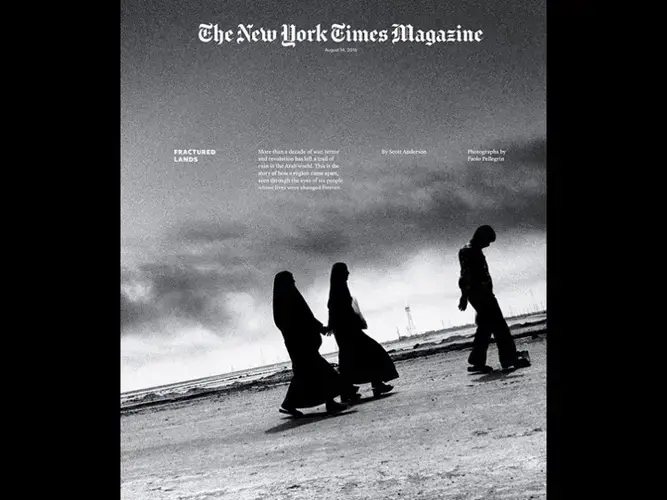
One last example: The big project we did with The New York Times Magazine last summer called “Fractured Lands,” with reporter Scott Anderson, photographer Paolo Pellegrin and videographer Ben Solomon. It took up the entire issue of The New York Times Magazine, with a 42,000-word essay that is believed to be the longest single piece in the history of The New York Times.
Scott Anderson tells the tragedy of the modern Middle East through six characters and details what’s happened to them in the last 15 years. It’s just haunting, beautifully written, reads like a novel and brings in all of this history. The Times got an enormous response, online, in print, and in dozens of other outlets.
Then we took the project out to our education network. Scott and I and others went to Columbia University and Yale, to Elon, to LaGuardia Community College, and so on. One of the most exciting venues was the Whitney M. Young High School in Chicago, an inner-city magnet school that happens to be Michelle Obama’s alma mater. The world history teacher there assigned 150 of her students to work on Scott’s piece for eight weeks. They studied it and made big timelines, trying to track the awful events in the Middle East with what was happening here at home.
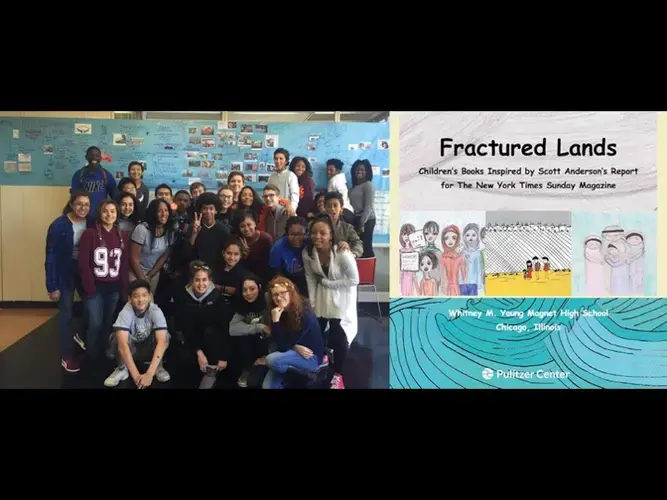
For our Lesson Builder, the online educational tool, Kem wrote a lesson plan that showed teachers how they could take Scott’s work and turn it into a theatrical piece. And when we were at Wake Forest with Scott last October he actually met with theater students, brainstorming how such a theatrical presentation might work. These weren’t history, journalism or international relations students; they were theater students. But they got very excited about doing a theatrical piece based on this. It’s exactly what NewsArts is meant to be.
And then Ann Michelle Boyle, the world history teacher at Whitney Young, saw what Kem had suggested and came up with her own approach, to create teams of artists and writers and have them take Scott’s big narrative and turn it into children’s books. So you have this complicated, sophisticated piece of reporting at The New York Times Magazine—dense, big, and long. And then you have it translated into something that these students could take out to younger children. They’re beautifully done. We’ve got copies of several of them on our website, the PDFs with some of the stories, and there’s actually a commercial publisher in Chicago who’s interested in publishing one of them.
We’re always trying to reach different audiences, and looking for different ways of thinking about these issues we cover.
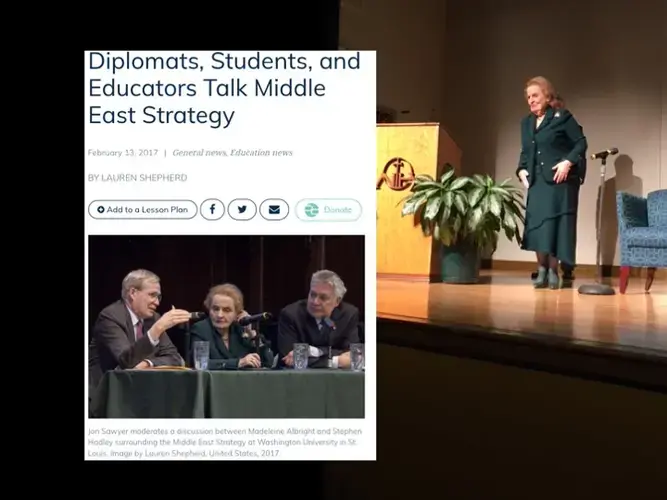
One of the readers who really was moved by Scott’s work was Madeleine Albright, the secretary of state under Bill Clinton. She and Steve Hadley, George W. Bush’s national security adviser, are co-chairs of the Atlantic Council’s Middle East Strategy Task Force, and last fall they were completing a two-year assessment on what to do in the Middle East, what is its future, what can we do to help reconstruct the Middle East. They got very excited about Scott’s work. They invited Scott and me to present the project in DC, at a small dinner that attracted ambassadors from the region and also policy-makers and think-tank experts. And out of that experience the Atlantic Council approached us to ask if Hadley and Albright might have an opportunity to reach out to the Pulitzer Center’s network of schools and universities.
We’ve got around 200 secondary schools plus 31 universities involved with the Pulitzer Center and we tapped into them to organize a tour. We were in St. Louis earlier this month, at Washington University and also a Catholic girls high school. Next week we’re at University of Pennsylvania and at an inner-city magnet school in Philadelphia. We hope to take Albright and Hadley in April to Spelman College and Clark University, historically-black schools in Atlanta, and then back to Chicago for presentations at Whitney Young High School and the University of Chicago.
When we visited Nerinx Hall, the Catholic girls school in Webster Groves, MO, there was total pandemonium when Madeleine Albright walked up to the stage. Here is an all-girls school and you have the first woman secretary of state. I was introducing her and there had been a lot of discussion beforehand about having a riser because, as you may recall, Madeleine is quite short. So I was arranging the riser as she walked up but then she walks past me and out to the front of the stage and does a sort of curtsy. You see in the photo that she’s all in green, from the dress down to the stockings and shoes. “I want you to know that I’ve researched your school,” she told the cheering students, “and I’m wearing Nerinx Hall green.” And the students just exploded. We made a video of the students responding to what they made of this visit. The longer version is on our website but I’ll show a short clip here.
I want to end with the Nerinx Hall visit because that is really the heart and soul of what the Pulitzer Center is about. You’re not going to find this on the cable shows denouncing Trump or defending Trump or denouncing the Democrats. That’s not what we do. I wish all of us would spend less time watching and listening to the noise on cable and more time reading and discussing with each other, across all groups and especially beyond our own political choirs, the issues that affect us all.
We believe that we can’t just be talking to ourselves, reading or watching media that echoes back the same views we already have. We have to really search out alternative sources of information—and then look for opportunities, whether it’s the group in this room right here or Reynolds High School or a girls’ school in St. Louis.
If we’re going to get through these times, through the challenges we face, that’s what all of us have to do. I know that we’re going to get through this, just as we’ve gotten through the many challenges that we Americans have faced together. I’m not going to make a prediction that in the near term all will end well. I learned my lesson when I was here two years ago—and I’m also not confident that things won’t get worse before they get better. But in the end I am confident that we’ll be fine, that the world, as I’ve said before, is better than we think. All of us should take heart that in the noise and emotion of this moment there is also energy and engagement, deeper and broader than we have seen for a long time. People are more alert and more energized. They’re paying attention. That’s a good thing. Once people are paying attention, seriously, I’m confident that we’ll get a good result.
And meanwhile, I appreciate the chance to be with you here today.






